How to Assemble: Char Broil Smoker, Roaster & Grill 10101550 Manual
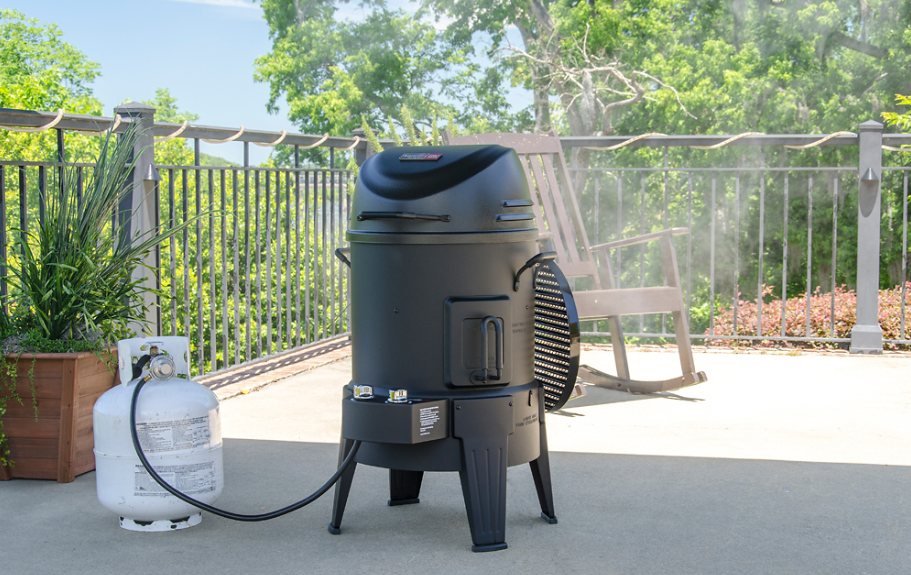
Content
Introduction of Char-Broil Smoker, Roaster & Grill 10101550
The Char-Broil Smoker, Roaster & Grill 10101550 is a versatile outdoor cooking appliance that allows you to smoke, roast, and grill your favorite foods. With a spacious 1,200 square inch cooking surface and a 10-hour plus smoking capacity, this unit is perfect for backyard barbecues, tailgating, and camping trips. The estimated price of this product is around $200, and it was launched in 2021.
PARTS DIAGRAM
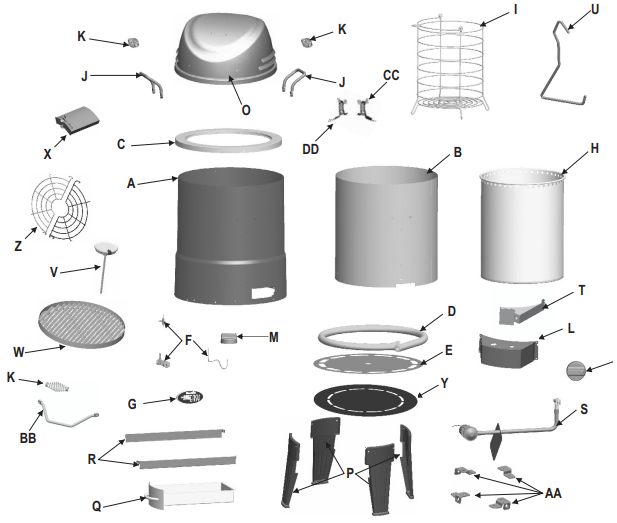
| Key | Qty | Description |
|---|---|---|
| A | 1 | Outer Body |
| B | 1 | Inner Body |
| C | 1 | Body Top Ring |
| D | 1 | Burner |
| E | 1 | Heat Shield |
| F | 1 | Ignition Kit |
| G | 1 | Logo Plate |
| H | 1 | Cooking Chamber |
| I | 1 | Roaster Basket |
| J | 2 | Side Handles |
| K | 3 | Handle Springs |
| L | 1 | Control Panel |
| M | 1 | Ignitor Knob |
| N | 1 | Control Knob |
| O | 1 | Top Lid |
| P | 4 | Leg Assembly |
| Q | 1 | Grease Tray |
| R | 2 | Grease Tray Rails |
| S | 1 | Hose, Valve, Regulator Assembly |
| T | 1 | Heat Shield (Duplicate, see E) |
| U | 1 | Lift Hook |
| V | 1 | Meat Thermometer |
| W | 1 | Cooking Grate Assembly |
| X | 1 | Smoker Box Assembly |
| Y | 1 | Wind Shield |
| Z | 2 | Wire Grate, Half Rack |
| AA | 4 | Burner Support |
| BB | 1 | Top Handle |
| CC | 1 | Hinge Assembly, Right |
| DD | 1 | Hinge Assembly, Left |
| ... | 1 | Hardware Pack |
| ... | 1 | Assembly Manual, English |
| ... | 1 | Assembly Manual, Spanish |
NOTE: Some grill parts shown in the assembly steps may differ slightly in appearance from those on your particular model. However, the method of assembly remains the same.
Detailed Specifications
The Char-Broil Smoker, Roaster & Grill 10101550 features a porcelain-coated cooking grate, a removable ash pan, a temperature gauge, and a lid-mounted thermometer. It has a total of 1,200 square inches of cooking surface, including a 22.5-inch main grate, a 14-inch secondary grate, and a 1,000 square inch smoking and roasting basket. The unit measures 45.5 x 23.4 x 47.2 inches and weighs approximately 80 pounds. It is powered by charcoal and has a wheeled base for easy mobility.
ASSEMBLY
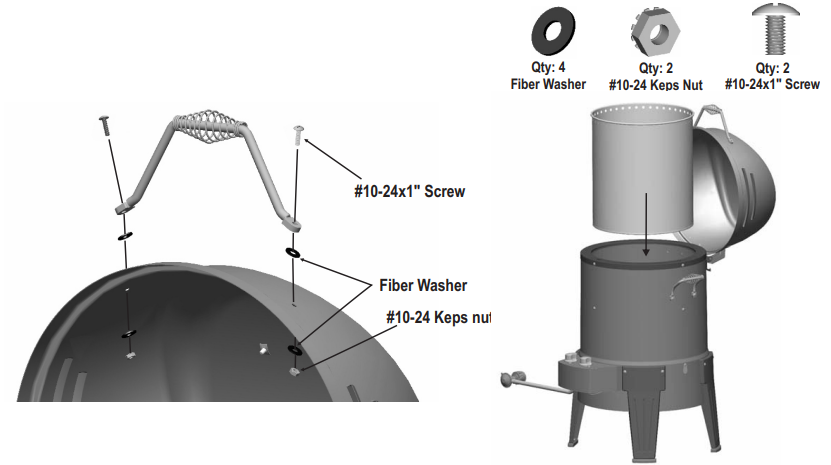
Tools required for assembly
Phillips Screwdriver (Not Supplied); Small Adjustable Wrench (Not Supplied)
Carefully turn the unit upside down.
Slide Heatshield into place over the exposed burner tube.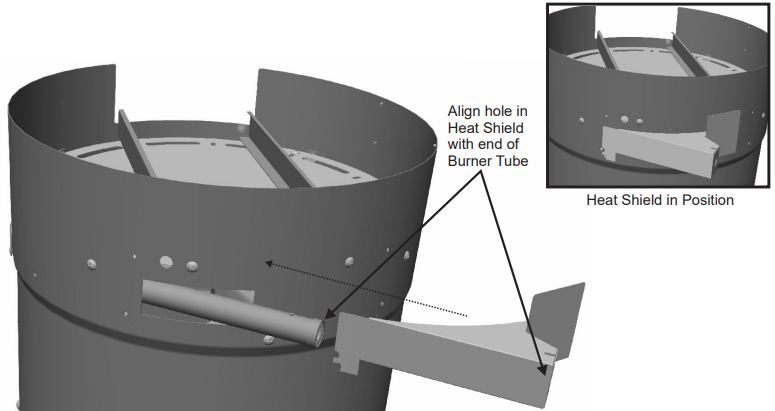
While holding the Heat Shield in place, slide the Control Panel Assembly into place, taking care to ensure that the valve engages the burner tube. shown Figure A
Install two #10x3/8" self-tap screws through the right side of the control panel. Leave screws loose.
Make sure valve is inside burner tube. Align the heat shield as shown Figure B.
Secure control panel using the two remaining #10x3/8” self-tap screws. Tighten all four screws.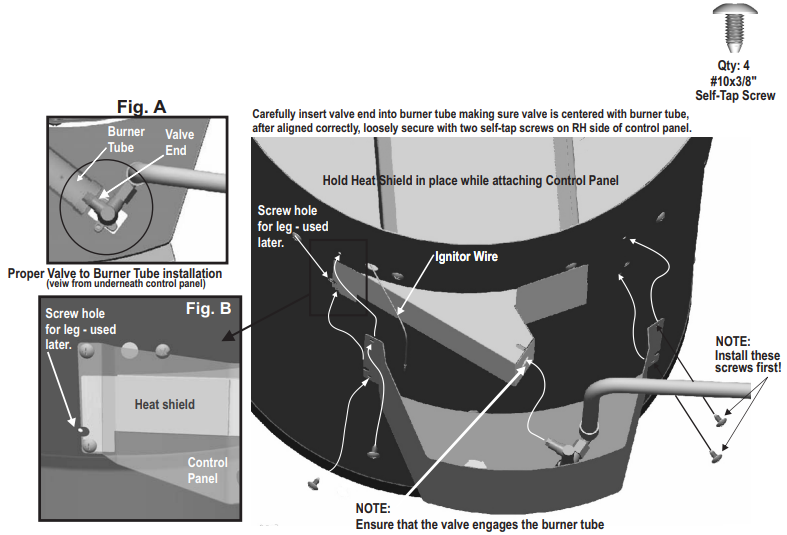
Attach round end of ignitor wire to electrode.
The ignitor wire is factory installed to the ignitor. Pass the loose end of the wire through the hole in the body, shown Figure A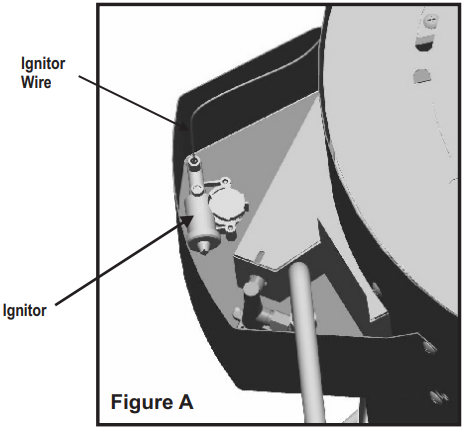
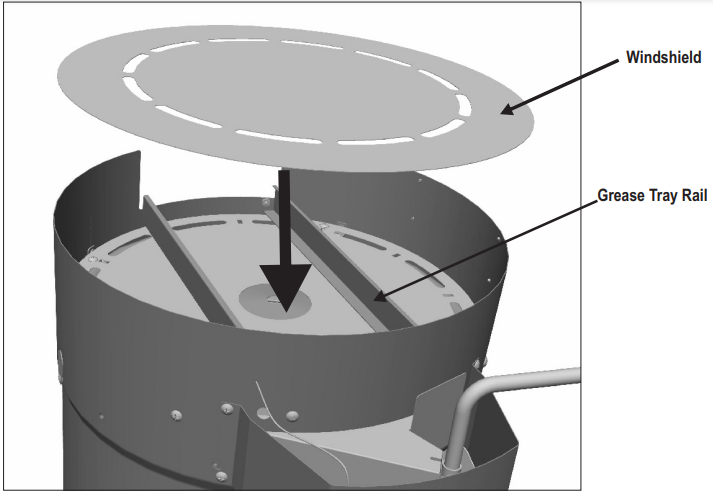
Place Windshield inside the bottom of the body.
NOTE: Fasteners are not required for the windshield. . The windshield is held in place once the legs are attached.Install legs by engaging leg tabs over bottom edge of the appliance body.
Once the leg is in place, attach two #10-24x1" screws through the leg and into the appliance body.
Repeat for the remaining legs.
When all four legs are securely installed, carefully turn the unit upright.
Slide the grease tray into the rear of the unit.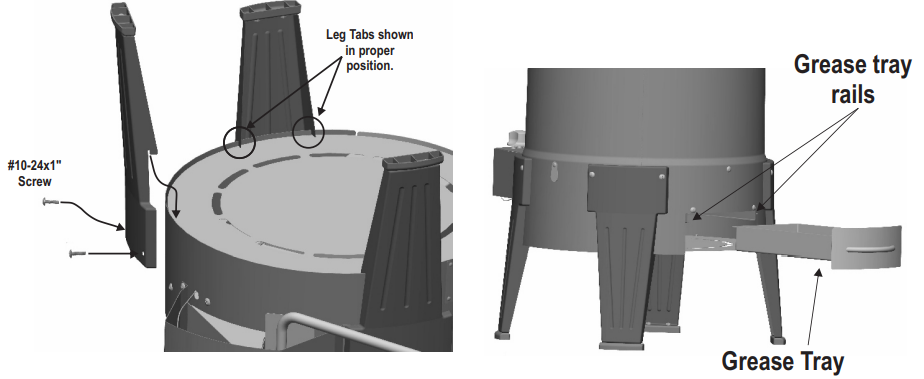
Attach the side handle assemblies to the unit using two #10-24x1/2" screw per handle.
Install the control knobs on to the valve stem and the ignitor stem.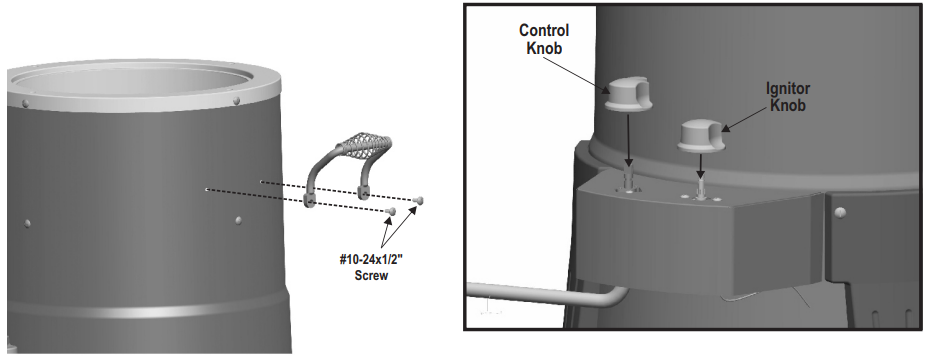
Attach the hinges to the lid inserting a #10-24x3/8" screw into hinge, install a fiber washer onto screw, align lid onto screw, install fiber washer from inside the lid, and finally secure with a #10-24 Keps nut. Repeat for opposite hinge. Shown A.

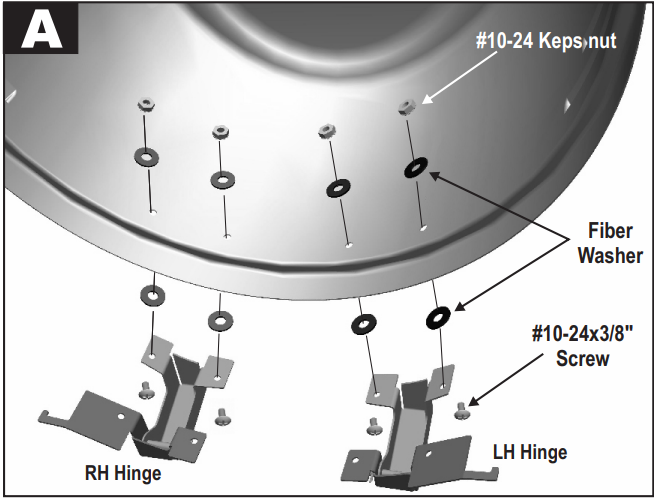
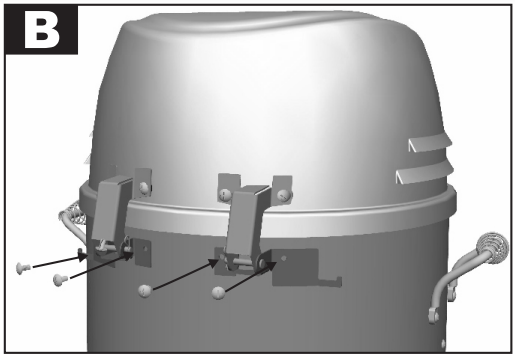
- Attach the lid handle by inserting a #10-24x1" screw into handle, install a fiber washer onto screw, align handle onto lid screw hole, install fiber washer from inside the lid, and finally secure with a #10-24 Keps nut.
Repeat for opposite side.
Slide the Cooking Chamber and Cooking Basket into the unit.
Accessory Use and Storage
NOTE: Before cooking on your appliance for the first time, refer to the separate Cooking Guide on how to prepare the appliance for cooking. It is recommended that you season your appliance prior to cooking.
- Once seasoning is complete, the appliance is now ready for use. The cooking chamber will continue to darken with use. This will inhibit rusting along with improving the performance of the infrared cooking system.
The bottom of the Cooking Grate has a locating ring. Be sure that the locating ring faces down and is centered in the cooking Chamber when using the Cooking Grate. Otherwise, the Cooking Grate could slip off the top of the appliance.
Never use the Cooking Grate upside down!
Note: Cooking Grateshown transparent for clarity
Never use the Cooking Grate upside down!- When using the Cooking Basket, insert it into the Cooking Chamber as shown
- Assembling your Half Racks into the cooking basket is very easy. Just insert the Half Rack through the side of the cooking basket at the desired level.
- Allow the Half Rack legs to rest securely on the cooking basket wire.
Make sure the legs are OUTSIDE of the cooking basket. This prevents the Half Racks from slipping.

Smoker Box
The Smoker Box has a clip that secures it into one of the four vent holes on the top ring of the appliance. Insert the clip as shown. When smoking, you will use the smoker box with the cooking basket.


Accessory storage
Accessory items such as the cooking grate, smoker box and half racks can be stored on board the Smoker, Roaster, & Grill as shown.

Installation Safety Precautions
- Use your appliance, as purchased, only with LP (propane) gas and the regulator/valve assembly supplied.
- The appliance installation must conform with local codes, or in their absence of local codes, with either the National Fuel Gas Code, ANSI Z223.1/ NFPA 54, Natural Gas and Propane Installation Code, CSA B149.1, and Propane Storage and Handling, CSA B149.2, Canadian Electrical Code, CSA C22.1 or the Standard for Recreational Vehicles, ANSI A 119.2/NFPA 1192, and CSA Z240 RV Series, Recreational Vehicle Code, as applicable.
- This appliance is not for use in or on recreational vehicles and/or boats.
- This appliance is safety certified for use in the United States and/or Canada only. Do not modify for use in any other location. Modification will result in a safety hazard.
WARNING: CALIFORNIA PROPOSITION 65
- Combustible by-products produced when using this product contains chemicals known to the State of California to cause cancer, birth defects, or other reproductive harm.
- This product contains chemicals, including lead and lead compounds, known to the State of California to cause cancer, birth defects or other reproductive harm. Wash your hands after handling this product.
Food Safety
Food safety is a very important part of enjoying the outdoor cooking experience. To keep food safe from harmful bacteria, follow these four basic steps:
Clean: Wash hands, utensils, and surfaces with hot soapy water before and after handling raw meat and poultry.
Separate: Separate raw meats and poultry from ready-to-eat foods to avoid cross contamination. Use a clean platter and utensils when removing cooked foods.
Cook: Cook meat and poultry thoroughly to kill bacteria. Use a thermometer to ensure proper internal food temperatures.
Chill: Refrigerate prepared foods and leftovers promptly.
Grease Tray
Never use drippings directly from the grease tray to make gravy. Use the included foil tray liner to catch drippings, then reheat the drippings to kill bacteria.
How To Tell If Meat Is Cooked Thoroughly
Meat and poultry cooked in the appliance often browns very fast on the outside. Use only thawed meat and a meat thermometer to be sure food has reached a safe internal temperature, and cut into food to check for visual signs of doneness.
We recommend food to be at least 40°F before cooking in your appliance.
Whole poultry should reach 165° F. Juices should run clear and flesh should not be pink.
Beef, veal and lamb steaks, roasts and pork chops can be cooked to 145° F.
NEVER partially cook meat or poultry and finish cooking later. Cook food completely to destroy harmful bacteria.
Use a meat thermometer to ensure proper internal food temperatures.
Storing Your Appliance
- Clean cooking basket.
- Store in dry location.
- When LP cylinder is connected to appliance, store outdoors in a well-ventilated space and out of reach of children.
- If the regulator is disconnected from the LP cylinder, a hook is provided to hang the regulator from the handle as shown.
- Cover appliance if stored outdoors. Choose from a variety of covers offered by the manufacturer.
- Store indoors ONLY if LP cylinder is turned off and is disconnected, removed from appliance and stored outdoors.
- When removing appliance from storage, follow “Cleaning the Burner Assembly” instructions before starting.
“For Best Results” Place poultry into the appliance with breast up as shown.

USE AND CARE
DANGER
- Never fill a cylinder beyond 80% full.
- An over filled or improperly stored cylinder is a hazard due to possible gas release from the safety relief valve. This could cause an intense fire with risk of property damage, serious injury or death.
- If you see, smell or hear gas escaping, immediately get away from the LP cylinder/appliance and call your fire department.
Keep LP tank at a minimum distance of 24” (inches) away from appliance at all times.
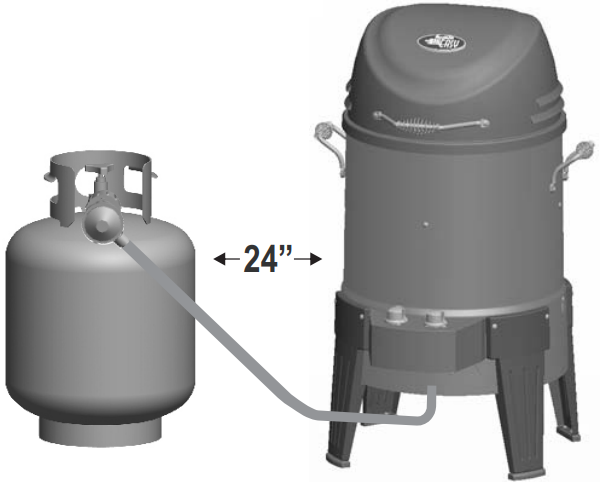
LP Cylinder Removal, Transport and Storage
Turn OFF the control knob and LP cylinder valve. Turn coupling nut counterclockwise by hand only – do not use tools to disconnect. Install safety cap onto LP cylinder valve. Always use cap and strap supplied with valve. Failure to use safety cap as directed may result in serious personal injury and/or property damage.
LP (Liquefied Petroleum Gas)
LP gas is nontoxic, odorless and colorless when produced. For Your Safety, LP gas has been given an odor (similar to rotten cabbage) so that it can be smelled.
LP gas is highly flammable and may ignite unexpectedly when mixed with air.
A disconnected LP cylinder in storage or being transported must have a safety cap installed (as shown). Do not store an LP cylinder in enclosed spaces such as a carport, garage, porch, covered patio or other building. Never leave an LP cylinder inside a vehicle which may become overheated by the sun.
Do not store an LP cylinder in an area where children play.

LP Cylinder
The LP cylinder used with your appliance must meet the following requirements:
Use LP cylinders only with these required measurements: 12″ (30.5cm) (diameter) x 18″ (45.7 cm) (tall) with 20 lb. (9 kg.) capacity maximum.
LP cylinders must be constructed and marked in accordance with specifications for LP cylinders of the U.S. Department of Transportation (DOT) or the National Standard of Canada, CAN/CSA-339, Cylinders, Spheres and Tubes for Transportation of Dangerous Goods; and commission, as applicable. See LP cylinder collar for marking.
LP cylinder valve must have:
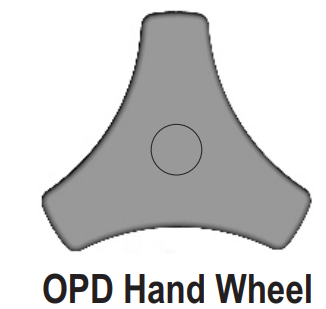
Type 1 outlet compatible with regulator or appliance. Safety relief valve. UL listed Overfill Protection Device (OPD). This OPD safety feature is identified by a unique triangular hand wheel. Use only LP cylinders equipped with this type of valve.
LP cylinder must be arranged for vapor withdrawal and include collar to protect LP cylinder valve. Always keep LP cylinders in upright position during use, transit or storage.
LP Cylinder Filling
Use only licensed and experienced dealers.
LP dealer must purge new cylinder before filling.
Dealer should NEVER fill LP cylinder more than 80% of LP cylinder volume. Volume of propane in cylinder will vary by temperature.
A frosty regulator indicates gas overfill. Immediately close LP cylinder valve and call local LP gas dealer for assistance.
Do not release liquid propane (LP) gas into the atmosphere. This is a hazardous practice.
To remove gas from LP cylinder, contact an LP dealer or call a local fire department for assistance. Check the telephone directory under “Gas Companies” for nearest certified LP dealers.
LP Cylinder Exchange
Many retailers that sell this appliance offer you the option of replacing your empty LP cylinder through an exchange service. Use only those reputable exchange companies that inspect, precision fill, test and certify their cylinders. Exchange your cylinder only for an OPD safety feature-equipped cylinder as described in the “LP Cylinder” section of this manual.
Always keep new and exchanged LP cylinders in upright position during use, transit or storage.
Leak test new and exchanged LP cylinders BEFORE connecting to the appliance.
LP Cylinder Leak Test
For your safety
Leak test must be repeated each time LP cylinder is exchanged or refilled.
Do not smoke during leak test.
Do not use an open flame to check for gas leaks.
This appliance must be leak tested outdoors in a well-ventilated area, away from ignition sources such as gas fired or electrical appliances. During leak test, keep appliance away from open flames or sparks.
Use a clean paintbrush and a 50/50 mild soap and water solution. Brush soapy solution onto areas indicated by arrows in figure below.
Do not use household cleaning agents. Damage to gas train components can result.

WARNING: If “growing” bubbles appear do not use or move the LP cylinder. Contact an LP gas supplier or your fire department!
Connecting Regulator to the LP Cylinder
LP cylinder must be properly secured onto appliance. (Refer to assembly section.)
Turn all control knobs to the OFF position.
Turn LP cylinder OFF by turning hand-wheel clockwise to a full stop.
Remove the protective cap from LP cylinder valve. Always use cap and strap supplied with valve.

WARNING: Do not use a POL transport plug (plastic part with external threads)! It will defeat the safety feature of the valve.
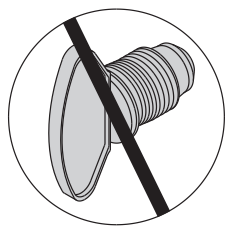
Hold regulator and insert nipple into LP cylinder valve. Hand-tighten the coupling nut, holding regulator in a straight line with LP cylinder valve so as not to cross-thread the connection.

Turn the coupling nut clockwise and tighten to a full stop. The regulator will seal on the back-check feature in the LP cylinder valve, resulting in some resistance. An additional one-half to three-quarters turn is required to complete the connection. Tighten by hand only – do not use tools.
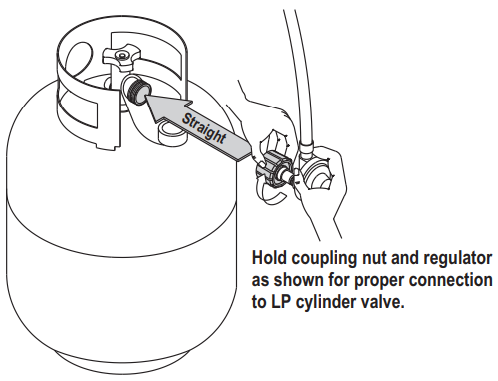
NOTE: If you cannot complete the connection, disconnect regulator and repeat steps 5 and 6. If you are still unable to complete the connection, do not use this regulator!
DANGER: Do not insert any tool or foreign object into the valve outlet or safety relief valve. You may damage the valve and cause a leak. Leaking propane may result in explosion, fire, severe personal injury, or death.
WARNING
This appliance is not intended to be installed in or on a boat.
This appliance is not intended to be installed in or on an RV.
Never attempt to attach this appliance to the self contained LP gas system of a camper trailer or motor home.
Do not use this appliance until leak-tested.
If a leak is detected at any time, STOP and call the fire department.
If you cannot stop a gas leak, immediately close LP cylinder valve and call LP gas supplier or your fire department!
Leak Testing Valves, Hose and Regulator
Turn control knob to OFF.
Be sure regulator is tightly connected to LP cylinder.
Completely open LP cylinder valve by turning hand wheel counterclockwise. If you hear a rushing sound, turn gas off immediately. There is a major leak at the connection. Correct before proceeding.
Brush soapy solution onto areas circled below.
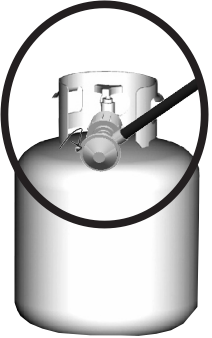
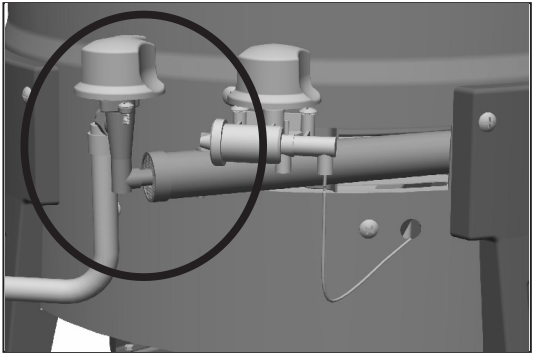
If “growing” bubbles appear, there is a leak. Close LP cylinder valve immediately and retighten connections. If leaks cannot be stopped do not try to repair. Call for replacement parts. Order new parts by giving the serial, model number and name and part number of items needed (see parts list) to the Grill Service Center at the number listed on front cover.
Always close LP cylinder valve after performing leak test by turning hand wheel clockwise.
For Safe Use of Your appliance and to Avoid Serious Injury
The use of alcohol, prescription or non-prescription drugs may impair the consumer’s ability to properly assemble or safely operate the appliance.
When cooking, the appliance must be on a level, stable noncombustible surface in an area clear of combustible material. An asphalt surface (blacktop) may not be acceptable for this purpose.
Do not leave appliance unattended. Keep children and pets away from the appliance at all times.
Do not place empty cooking vessel on the appliance while in operation. Use caution when placing anything in cooking vessel while the appliance is in operation.
Do not move the appliance when in use. Allow the cooking vessel to cool to 115°F (45°C) before moving or storing.
This appliance is not intended for and should never be used as a heater.
This appliance will be hot during and after use. Use insulated oven mitts or gloves and long-handled barbecue utensils for protection from hot surfaces or splatter from cooking liquids.
Keep appliance area clear and free from materials that burn.
Keep appliance area clear and free from combustible materials, gasoline and other flammable vapors and liquids.
Keep fuel supply hose away from any heated surfaces.
Use appliance only in well-ventilated space. NEVER use in enclosed space such as carport, garage, porch, covered patio, or under an overhead structure of any kind.
Use appliance at least 3 ft. from any wall or surface. Maintain 10 ft. clearance to objects that can catch fire or sources of ignition such as pilot lights on water heaters, live electrical appliances, etc.
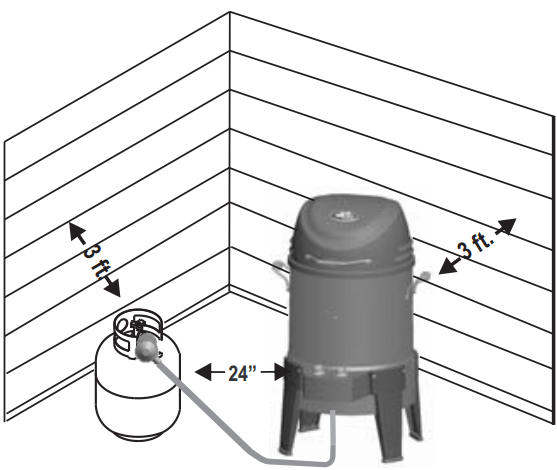
Apartment Dwellers
Check with management to learn the requirements and fire codes for using an LP gas appliance in your apartment complex. If allowed, use outside on the ground floor with a three (3) foot clearance from walls or rails. Do not use on or under balconies.
- NEVER attempt to light burner with any type of closed cover . A buildup of non-ignited gas inside a closed appliance is hazardous.
- Never operate appliance with LP cylinder out of correct position specified in assembly instructions.
- Always close LP cylinder valve and remove coupling nut before moving LP cylinder from specified operation position.
Safety Tips
- Before opening LP cylinder valve, check the coupling nut for tightness.
- When this appliance is not in use, turn off control knob and LP cylinder valve.
- The grease tray must be inserted into appliance and emptied after each use.
- If you notice grease or other hot material dripping from appliance onto valve, hose or regulator, turn off gas supply at once. Determine the cause, correct it, then clean and inspect valve, hose and regulator before continuing. Perform a leak test.
- Do not store objects or materials under the appliance enclosure that would block the flow of combustion air to the underside of either the control panel or the firebox bowl.
- The regulator may make a humming or whistling noise during operation. This will not affect safety or use of the appliance.
- If you have an appliance problem see the "Troubleshooting Section".
- If the regulator frosts, turn off appliance and LP cylinder valve
Ignitor Lighting
Do not lean over appliance while lighting.
Turn ON LP gas cylinder.
Press and turn the control knob to
Turn ROTARY IGNITOR knob rapidly.
If ignition does not occur in 5 seconds, turn the burner control knob O OFF, wait 5 minutes, and repeat lighting procedure.
If ignition still does not occur, follow match-lighting instructions.
WARNING: Turn control knob and LP cylinder OFF when not in use.
CAUTION: If ignition does NOT occur in 5 seconds, turn the control knob OFF, wait 5 minutes and repeat the lighting procedure. If the burner does not ignite with the valve open, gas will continue to flow out of the burner and could accidently ignite with risk of injury.
Match-Lighting
Do not lean over appliance while lighting.
Turn ON LP cylinder.
Swing match hole plate to expose match lighting hole. Place lit match into match lighting hole of appliance as pictured below. Make sure lit match is placed inside hole and near burner.
Push in and turn control knob to Be sure burner lights and stays lit.
Once lit, swing match hole plate back to cover up match lighting hole.
Caution: Plate maybe hot.
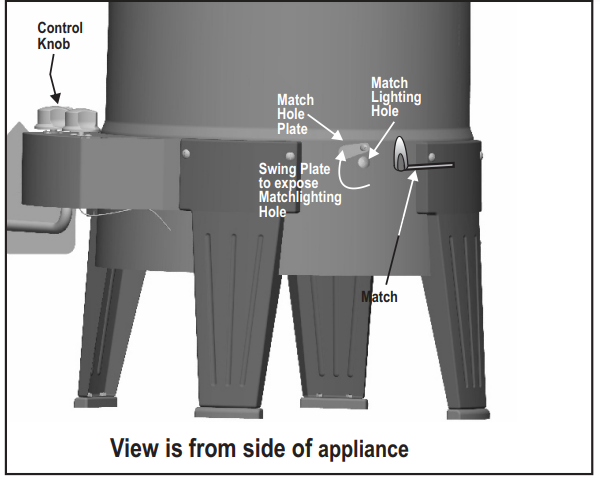
View is from side of appliance
Burner Flame Check
Light burner. Looking through viewing hole on top of appliance, you should see the flame height as shown below. Turn control knob from to OFF. The Flame height should decrease and then go out. Always check flame prior to each use. If only low flame is seen refer to “Sudden drop or low flame” in the Troubleshooting Section.

Ignitor Check
Turn gas off at LP cylinder. Turn ignitor knob. “Click” should be heard each time at electrode. See “Troubleshooting” if no click or spark.Valve Check
Important: Make sure gas is off at LP cylinder before checking valve. Knob locks in OFF position. To check valve, first push in knob and release, knob should spring back. If knob does not spring back, replace valve assembly before using this appliance. Turn knob to position then turn back to OFF position. Valve should turn smoothly.Hose Check
Before each use, check to see if hose is cut, worn or kinked. Replace damaged hose before using appliance. Use only valve/hose/regulator specified by manufacturer.
General Appliance Cleaning
Meat Thermometer: Do not immerse or soak in water. Wash with warm soapy water and wipe dry.
Do not mistake brown or black accumulation of grease and smoke for paint. Interiors are not painted at the factory (and should never be painted). Apply a strong solution of detergent and water or use a grill cleaner with scrub brush on insides of appliance lid and bottom. Rinse and allow to completely air dry. Do not apply a caustic grill/oven cleaner to painted surfaces. A black surface improves the appliances performance.
Plastic parts: Wash with warm soapy water and wipe dry. Do not use citrisol, abrasive cleaners, degreasers or a concentrated grill cleaner on plastic parts. Damage to and failure of parts can result.
Painted surfaces: Wash with mild detergent or non-abrasive cleaner and warm soapy water. Wipe dry with a soft nonabrasive cloth.
Stainless steel surfaces: To maintain the high quality appearance, wash with mild detergent and warm soapy water and wipe dry with a soft cloth after each use. Baked-on grease deposits may require the use of an abrasive plastic cleaning pad. Use only in direction of brushed finish to avoid damage. Do not use abrasive pad on areas with graphics.
CAUTION

If your appliance is getting hard to light or the flame is weak, check and clean the venturi’s and burners. Spiders or small insects are know to create “flashback” problems by building nests and laying eggs in the appliance venturi or burner obstructing the flow of gas. The back-up gas can ignite behind the control panel. This flashback can damage your appliance and cause injury.
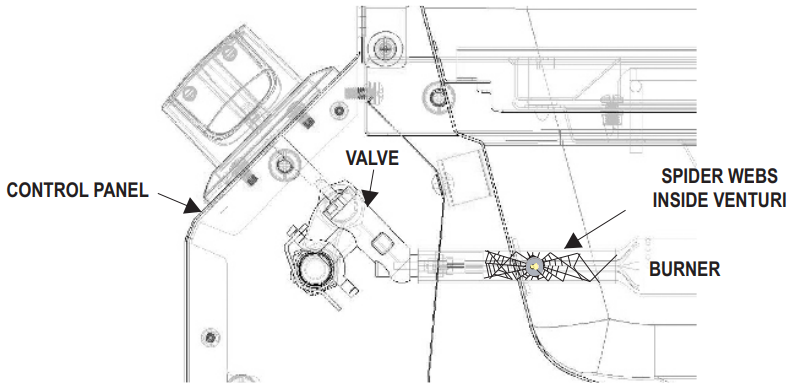
To prevent flashbacks and ensure good performance the burner and venturi tube assembly should be removed and cleaned when ever the appliance has been idle for an extended period of time.
Cleaning the Burner Assembly
Follow these instructions to clean and/or replace parts of burner assembly or if you have trouble igniting appliance.
- Turn gas OFF at control knob and LP cylinder and disengage regulator from cylinder.
- Open top cover, remove cooking basket and cooking Chamber, shown A. This will expose the burner from inside, shown B.
- Wire brush entire outer surface of burner to remove food residue and dirt.
- Clean any blocked ports with a stiff wire such as an open paper clip.
- Carefully lay the appliance on its back, with control panel facing up shown C.
- Disconnect electrode wire underneath appliance, shown C.
- Remove screws and disengage front legs from appliance.
- Remove screws and disengage control panel assembly and eat shield from unit, shown D.
Clean inner burner as recommended below, shown E. We suggest three ways to clean the burner tube. Use the one easiest for you.
(A) Bend a stiff wire (a light weight coat hanger works well) into a small hook. Run hook through burner tube several times.
(B) Use a narrow bottle brush with a flexible handle (do not use a brass wire brush), run the brush through burner tube several times.
(C) Wear eye protection: Use an air hose to force air into the burner tube and out the burner ports. Check each port to make sure air comes out each hole.
Check burner for damage, due to normal wear and corrosion some holes may become enlarged. If any large cracks or holes are found replace burner.
Attach electrode to burner.
Carefully replace control panel assembly .
VERY IMPORTANT: Burner tube must re-engage over valve opening. See illustration, shown F.Reposition inner liner, cooking basket and top cover.
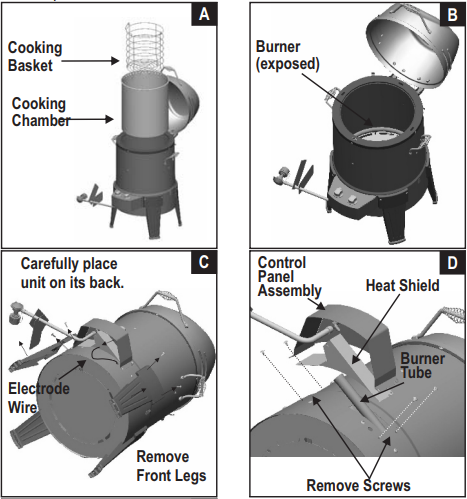

Description of Char-Broil Smoker, Roaster & Grill 10101550
The Char-Broil Smoker, Roaster & Grill 10101550 is a three-in-one outdoor cooking appliance that allows you to smoke, roast, and grill your favorite foods. The porcelain-coated cooking grates ensure even heat distribution and easy food release, while the removable ash pan makes clean-up a breeze. The temperature gauge and lid-mounted thermometer allow for precise temperature control, ensuring perfectly cooked meals every time. The spacious cooking surface and smoking basket provide ample room for cooking a variety of foods, from burgers and hot dogs to whole chickens and roasts.
EMERGENCIES: If a gas leak cannot be stopped, or a fire occurs due to gas leakage, call the fire department.
Emergencies | Possible Cause | Prevention/Solution |
Gas leaking from cracked/cut/burned hose.
Gas leaking from LP cylinder. Gas leaking from LP cylinder valve. Gas leaking between LP cylinder and regulator connection. Fire coming through control panel.
Grease fire or continuous excessive flames above cooking surface. |
|
|
Char-Broil Smoker, Roaster Setup Guide
To set up the Char-Broil Smoker, Roaster & Grill 10101550, follow these steps:
- Assemble the unit according to the instructions in the manual.
- Fill the charcoal chamber with charcoal and light it using a charcoal chimney or an electric starter.
- Adjust the dampers to control the airflow and temperature.
- Place the food on the cooking grates or in the smoking and roasting basket.
- Close the lid and cook the food according to the recommended times and temperatures.
Troubleshooting
Problem | Possible Cause | Prevention/Solution |
Burner will not light using ignitor. | GAS ISSUES:
ELECTRICAL ISSUES:
|
|
Burner will not light using ignitor. |
|
|
Burner will not match light. |
|
|
Sudden drop in gas flow or low flame. |
|
|
Flames blow out. |
|
|
Flare-up. |
|
|
Persistent grease fire. |
|
|
Flashback... (fire in burner ). |
|
|
Unable to fill LP cylinder. |
|
|
Cooking slower than expected |
|
|
Char-Broil Warranty
This warranty only applies to units purchased from an authorized retailer. Char-Broil Smoker, Roaster & Grill 10101550 comes with a one-year warranty
Pros & Cons
Pros
- Versatile three-in-one design
- Spacious cooking surface and smoking basket
- Precise temperature control
- Easy clean-up with removable ash pan
- Wheeled base for easy mobility
Cons
- Charcoal fuel source can be messy and time-consuming
- Temperature control can be tricky for beginners
- Lid-mounted thermometer is not always accurate
- Assembly can be challenging for some users
Customer Reviews about Grill 10101550
Customers generally have positive things to say about the Char-Broil Smoker, Roaster & Grill 10101550. They appreciate the versatile design and spacious cooking surface, and many note that the unit is easy to assemble and use. However, some users have reported issues with temperature control and fuel efficiency. The lid-mounted thermometer has also been criticized for its accuracy.
Faqs
Is it safe to line the drip tray with aluminum foil for Char-Broil Smoker, Roaster & Grill 10101550 easier cleaning?
How do I initiate the first use of my Char-Broil Smoker, Roaster & Grill 10101550 appliance safely?
What maintenance routines should I regularly perform on my Char-Broil Smoker, Roaster & Grill 10101550 unit?
How can I effectively troubleshoot a failure to ignite in my Char-Broil Smoker, Roaster & Grill 10101550?
What is the recommended method for cleaning the cooking Char-Broil Smoker, Roaster & Grill 10101550?
Can I use my Char-Broil Smoker, Roaster & Grill 10101550 model in adverse weather conditions, such as rain or snow?
What is the warranty on the Char-Broil Smoker, Roaster & Grill 10101550?
How do I correctly store my Char-Broil Smoker, Roaster & Grill 10101550 when not in use?
What's the safest way to check for gas leaks on my Char-Broil Smoker, Roaster & Grill 10101550?
What's the best way to prevent flare-ups during Char-Broil Smoker, Roaster & Grill 10101550?
Leave a Comment
